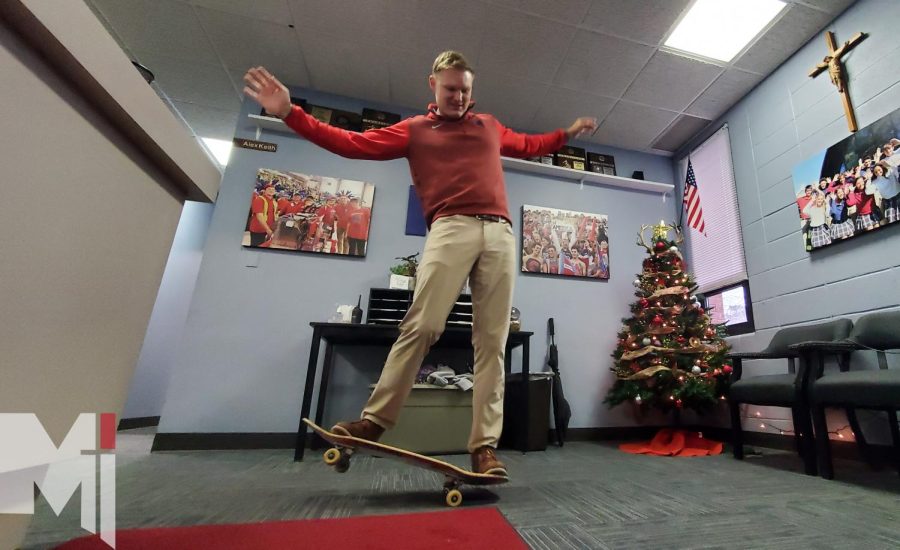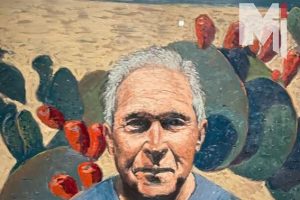Wheels Down, Shirts Tucked: Skateboarding lives in all walks of students, faculty
Dean of Students, Alex Keith is seen holding a nose manual inside the attendance office. Keith is one of multiple Stags who love to skate.
December 20, 2022
Unified with a history of counter-culture, senior Alex Owens, junior Diego Melgoza and Dean of Students Alex Keith have sought exercise and community building through the non-competitive and non-commercial act of skateboarding.
Skateboarding has spread its roots in Kansas City since the early 2000s and prior with the opening of Escapists Skateboarding in the Crossroads in 2000 and the international introduction of world champion Kansas City skater Sean Malto in the 2010s. Malto is a sponsored, or financially supported, skater who has served as an inspiration for many young skaters in Kansas City and has been widely recognized as a humble figure that has continued to “ride” for his city.
“I saw that Sean Malto had a sponsorship from Escapists, and being from Kansas City with a sponsorship from Girl Skateboards too is cool,” Diego Melgoza, junior and skater of four years said. “He really inspired me.”
Malto’s influence has breached generational gaps, so while younger skaters idolize his legacy, some older ones recall his earlier career.
“I was fortunate enough to skate alongside Sean Malto for quite a while,” Alex Keith, a skater of twenty years said. “It’s one of those things where he’s actually as cool as he seems.”
Individuals such as Malto are paramount to the regional unification that skateboarding has provided, and having major brand sponsorships such as Girl Skateboards goes to further their cultural reach.
Skate brands, since the dawn of mainstream skateboarding, have worked as public exhibits of the ever-evolving culture of street skating by producing videos, clothing and various skate paraphernalia for their various consumers.
“I want to be sponsored by Krooked,” Alex Owens, senior and skater of two years said. ”I love their decks, great graphics from Independent too.”
With skate culture being based on pushing the limitations of one’s body and creative mind, it innately undercuts the consumer culture that has enveloped most of the public sporting domain. Earning a sponsorship is regarded more as a recognition of skill, instead of exclusively being an outlet for memorabilia.
“If I’m doing purely the materialistic thing, I’d say, ‘Oh, well put me on Nike and I can just get all of the things forever,’ but I don’t think that would make me the happiest,” Keith said. “It’d probably be Girl. I’ve always been a huge fan of theirs.”
Culture is the cornerstone of skateboarding, and an ever-changing one at that, with some organizations in recent years having utilized the activity and its influence for superficial digital gain, typically with a kickback from the wider community.
“The Cariuma brand and their social-media-skateboarding push, I think it’s cool because it gets people in the skateboarding because it’s so big, but at the same time, it’s kind of corny,” Owens said.
Beyond brands, specific individuals have been put under the community crosshair for “selling out.”
“When you see a skater make it big, somebody like Nyjah Houston or something like that, there’s always hesitancy from real skaters out there,” Keith said.
The commodification of skateboarding has elicited a resilient response from skaters, as it undermines the personal effect that progressing through skateboarding provides. The rigorous nature of skating challenges one physically and mentally, demanding extensive work with interspersed moments of jubilant victory, providing a uniquely personal experience.
“When I learned my first pop shove in my garage, I filmed a slow-motion video of it, and I’m still watching it today,” Melgoza said. “I felt really proud at that moment.”
Skaters’ trick repertoires are often their proudest feature, with their most memorable battles for tricks living as vivid memories.
“The first time I ever bored slid a rail was unbelievable …. I was running up to it and I’d stop, until finally, something snapped in me and I just said, ‘You know what, I might fall and break both my arms, but I’m going to do it anyways, I’m just going to go for it,’” Keith said.
While learning tricks and developing skills is the process that keeps one skating, the community that a skater integrates into through that process is often the most cherished aspect.
“Just those late nights at 9 or 10 when you’re with our friends at the park, it’s dark out and it’s a summer night, you’re just sitting in the bowl, staring at the night sky and talking about stuff,” Owens said. “I love that.”
Influence from skateboarding has extended through generations both within Miege and without and has had a major stake in fashion and street culture since the 1960s.
The lessons learned through skateboarding have proved applicable beyond the board, which has led Keith to involve his children in the internally developmental hobby.
“I’m getting my son on a board young so that he’s comfortable with it,” Keith said. “He’s not afraid of falling and getting back up.”
Through intergenerational efforts to further equip individuals with prioritization of bravery and self-development over superficial gain, skateboarding’s influence reaches outside the park.
“Eventually, you realize that you have the skills to do something, but it’s just your mind that you have to conquer, and when you conquer your mind, it’s fun, it’s exciting,” Keith said.







